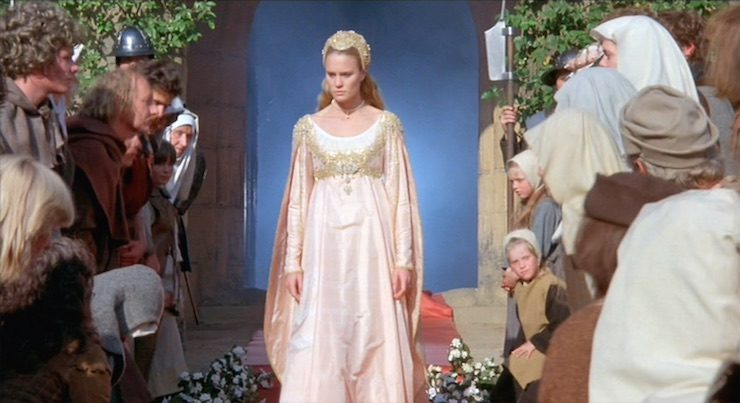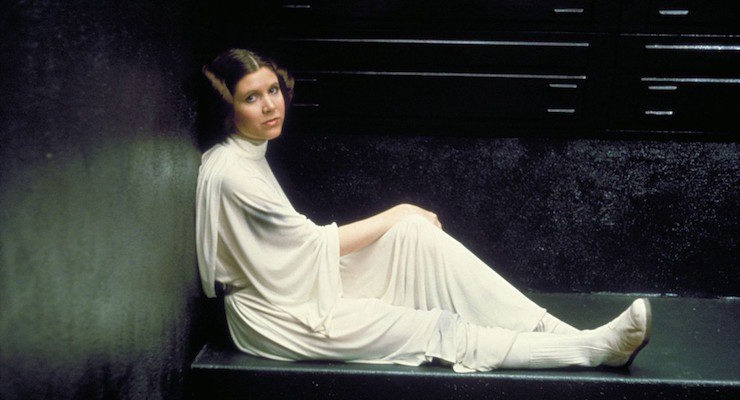You do not see the woman in white head-on.
Not at first. She is not looking at you. She is looking at something else, someone more important. She has a purpose. She has a vision. You are not worthy.
When she does look at you, she does not smile. You feel even less worthy, unworthy even to touch the hem of her robe. Or is it a cloak? Or a gown? It doesn’t matter. It’s too good for you.
She is too good for you.
In a blood-soaked world where survival is dependent upon grit and determination, the woman in white is spotless. She is radiant. She is pure.
The woman in white is often used as a main character’s motivation. She is his comfort in times of trouble, the source of his courage, and the object of his protection. His journey is one of attempting to become worthy of the woman in white and all she represents. His reward is her approval, her affection, her respect.
She is a thing worth dying for.

When a costumer selects a broad white expanse of cloth for a female character, they are making a statement about that character. She is pristine—an assigned value which means many things. She has never killed before. She is a virgin. She is wealthy, or at least well-kept. She is civilized. When a male protagonist sees the woman in white, he sees everything that, to a western colonialist narrative, is worth protecting: virtue, patience, stability, and purity. The woman in white reminds the hero of what he is fighting for. He is fighting for that white cloak—for its ability to remain unblemished, no matter what.
For her part, the woman in white must remain pure and radiant in order to continue motivating that hero. He will do whatever it takes to protect her and the things she stands for; thus, it is her solemn duty to remain unblemished. If she doesn’t (or so the logic goes)—if she lets him see a stain on her white gown—then the hero will stop fighting, and all will be lost.

Sometimes, the woman in white is used to reinforce an existing narrative. She is presented to a hero, and he is inspired, and he fights for her, and at the end of the day perhaps he is allowed to sleep curled at the foot of her bed.
Other times—and frequently in contemporary film and television—the woman in white is used to subvert that existing narrative. She is presented to a hero, and he is inspired, and he fights for her… and then she grabs a gun or a sword or a magical staff and fights for herself, because that hero isn’t doing the job well enough. This subversion is delightful to viewers who feel the societal constraints of being the woman in white, because it reminds them: you do not have to remain spotless and fearful while someone else fights for you. You can fight for yourself.
That said, the subversion of the woman in white is also frequently played to delight viewers who identify strongly with the male protagonists. After all, what is more delightful than seeing a woman pulled off of a pedestal?

There is no greater example of this narrative decay than in the character of Leia Organa. In the original Star Wars trilogy, Leia’s character shifts along with her costume. In A New Hope, she is clothed entirely in white. For the first half of the film, she serves as a motivating force in Luke’s journey—while she’s not afraid to take matters into her own hands, she is demonstrably aware of her status. Despite Luke and Han’s evident attraction to her, she is not available to either of them. Even at the end of the film, when she is acknowledging them as heroes, Leia is clad almost entirely in white.
But by then, they’ve earned her smile.

Throughout Empire Strikes Back, Leia shifts between being a woman in white and a more relatable, available character. The more emotion she shows—the more vulnerability she shows—she more color she wears. Her Hoth snowsuit is white, but dingy and damaged in places, and her boots are gray—and it’s this outfit that she wears while she’s arguing with Han, allowing him to treat her as an equal rather than a superior. Similarly, her russet Bespin gown is worn under an off-white cloak at cloud city, tipping off the viewer that she’s not as invulnerable as she might seem. At the end of the film, the only signal of her safety—and her renewed loneliness—is the return of her white gown.

By the time Leia Organa makes it to Return of the Jedi, her white garments are gone. She’s rebel scum now, through-and-through; she’s available to Han, comrades with Luke. She’s shot and lied and bluffed her way through a revolution. Her Boushh disguise—the clothes of a bounty hunter—are used as a shocking reveal for the viewer, who is used to thinking of her as a woman in white (or at least a woman in off-white). The disguise serves as a narrative reinforcement: it’s been a while since Cloud City, the viewer is reminded, and Leia is not the same person she was before. In a way, this softens her transition into the notorious bikini, making that transition more palatable to the audience. This is not a princess, we are reminded; this is not a woman in white. This is a rebel. Feel bad for her, but not too bad—she’s not what Luke is fighting for, not anymore. She’s on her own, and if she winds up in a bikini with a chain shackled to her throat, so be it.

After her escape from Jabba the Hutt, Leia is not returned to her former status as a woman in white. If she was, the viewer would not believe it—we have seen her fall from her pedestal. We have seen her in vulnerable, risky positions. We have seen her kill. She can no longer be a passive, celestial motivator for a male protagonist—instead, she has become a protagonist in her own right. She is allowed to smile at last, because her white chemise is dominated by her brown dress. And she must wear the brown dress, because she has been allowed to smile.

 Sarah Gailey’s fiction has appeared in Mothership Zeta and Fireside Fiction; her nonfiction has been published by Mashable and Fantasy Literature Magazine. You can see pictures of her puppy and get updates on her work by clicking here. She tweets @gaileyfrey. Watch for her debut novella, River of Teeth, from Tor.com in May of 2017.
Sarah Gailey’s fiction has appeared in Mothership Zeta and Fireside Fiction; her nonfiction has been published by Mashable and Fantasy Literature Magazine. You can see pictures of her puppy and get updates on her work by clicking here. She tweets @gaileyfrey. Watch for her debut novella, River of Teeth, from Tor.com in May of 2017.










